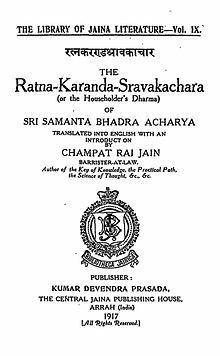Period 2nd Century CE | ||
 | ||
Similar Samayasāra, Puruşārthasiddhyupāya, Shatkhandagama, Tattvartha Sutra, Dravyasamgraha | ||
Ratnakaranda śrāvakācāra is a Jain text composed by Samantbhadra, an acharya of the Digambara sect of Jainism. Samantbhadra was originally from Kanchipuram, Tamil Nadu. Ratnakaranda śrāvakācāra is the earliest and one of the best-known śrāvakācāra.
Contents
A śrāvakācāra discusses the conduct of a Śrāvaka or Jain lay practitioner.
Overview
First verse of the Ratnakaranda śrāvakācāra is dedicated to Vardhamāna Mahāvīra, the 24th Tirthankara:
Namāh śri Vardhamāna-e nirdhutakalilātmaneSālokānāma trilokānāma yadā-vidyā darpanāyate! (1-1)Tr.- I bow to Śri Vardhamāna Mahāvīra who has washed off [all] the impurities of karmic filth from His Soul, [and] In Whose Perception scintillate the three Worlds and the infinity of Space, as in a mirror !
Chapters
Seven chapters or parts of the Ratnakaranda śrāvakācāra are:
- Right Faith
- Characteristics of Right Knowledge
- Anuvrata
- Guņa vratas
- Śikşā vratas
- Sallekhanā
- Eleven Pratimas
Translation
Ratnakaranda śrāvakācāra was first translated in English language in 1917 by Champat Rai Jain. It was named "The Householder's Dharma" which means the conduct of a householder.
